On The Record with Clarke Weatherspoon, USAWP Racial Equity & Reform Task Force Member
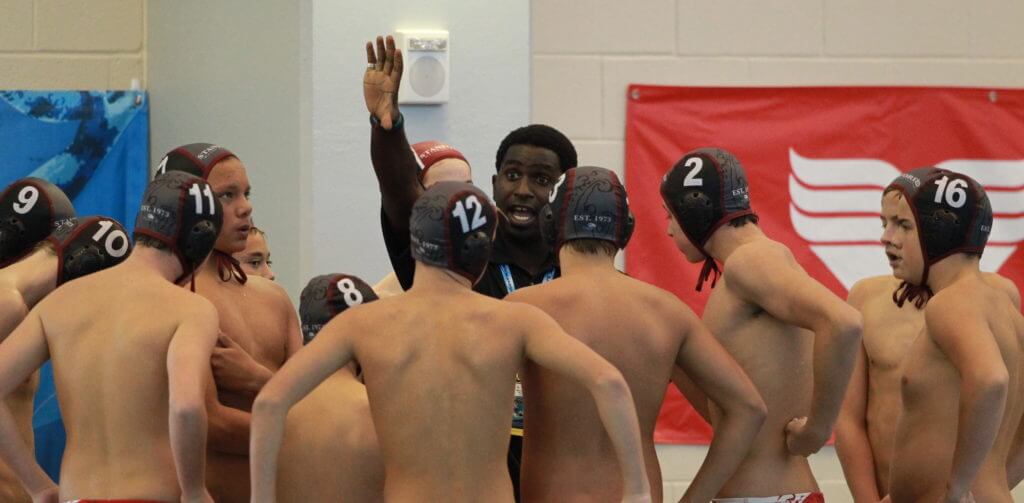
During a moment of extreme disruption in American society, including unrest due to continued racial discrimination and violence, Clarke Weatherspoon and USA Water Polo’s Racial Equity & Reform Task Force seek to open up swimming and water polo to all, regardless of race or gender.
It is no surprise that Weatherspoon, an educator who for more than a decade was an age group coach with Stanford Water Polo Club, and has been head of the Middle School at San Francisco Friends School the past two years, is part of this potentially ground-breaking initiative. A former water polo athlete at Phillips Exeter in New Hampshire as well as at UC Santa Barbara, he is a passionate promoter of polo who believes sports can address inequality in our society.
In a recent interview with Swimming World, Weatherspoon talks about his start in swimming with the Rogers—first Roger Wycoff, a swim coach, and then Roger Nekton, coach of the Exeter swim and polo teams—his journey to California for polo, his success with Stanford’s 14U boys and girls teams, his participation with the Racial Diversity and Equity Task Force, and how much work needs to be done to make aquatics available to all.
***
– You grew up in New Hampshire, not exactly a water polo hotbed.
My dad is a long-time faculty member at Phillips Exeter. That was where I spent a big chunk of my childhood. I started age group swimming when I was a kid. I was competing on a swim team for a retired army colonel named Roger Wycoff who was a really amazing coach.
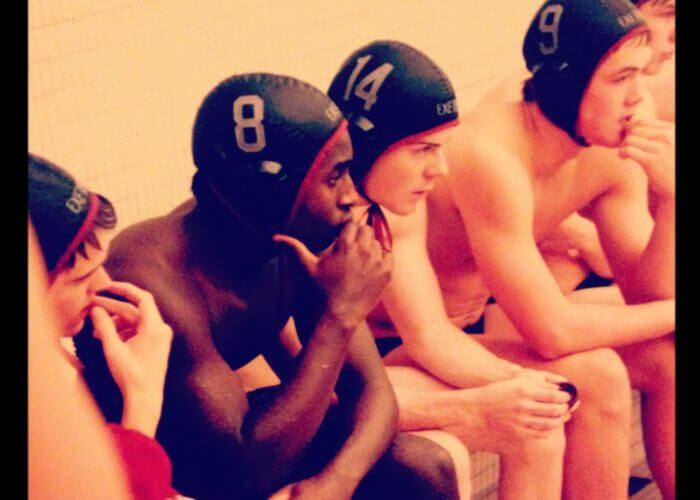
Weatherspoon at Phillips Exeter. Photo Courtesy: C. Weatherspoon
On the swim team there were just two families: his children and me and my siblings. He was an inspiring coach, and when we moved to New Hampshire, the first year I was there I didn’t swim. I remember going to my parents [and saying]: We’ve got to swim! Swimming is important! One of my dad’s colleagues, a man by the name of Roger Nekton was the coach at Phillips Exeter who had a son my age.
I was one of those kids who was always at the bottom of the pool or pulling on people or the lane lines—all the things that drive some coaches crazy. When I saw there was a sport that involved being social, having your head out of the water and playing with a ball, that was the best of all worlds.
I played through high school then spoke to Mr. Nekton about where he thought I might be able to play in college.
I really wanted to come to California. I didn’t go through a serious West Coast recruiting experience. I got some feedback from Coach Nekton and he mentioned UCSB. I applied, ended up getting in and contacted Joe O’Brien [UCSB head coach] at the end of the summer.
– That’s a big dive in—going to California to play water polo. How was it acclimating to playing in the mecca for the sport in America?
I don’t know that a lot of [California] colleges have open tryouts. It just happens that year, where UCSB water polo was in its history, there had been a coaching transition—Pete Snyder had been the coach for a long time—then Joe O’Brien came in. As any new coach comes in there’s a transition of players.
[On The Record with Pete Snyder, Head Coach for the 1979 UC Santa Barbara Men’s Water Polo Team]
You think about your classic high school tryout. You’ve got people who have never played, people who are already on the team, [including] the captain and everything in between. I remember showing up at the pool and there were a lot of guys. There was a swim test set and drills… I’m forgetting how long it was; in my mind it was a week but it could have been three or four days. But, it was a fascinating experience, and when it came down there was a list of 20 – 25 guys and my name on it.
– California water polo is not known for its diversity—and Eastern athletes are not common out West.
The year I was on the team, there were a few other East Coast players. There were two guys who played at the Annapolis club, there was a guy who played at Greenwich High School—and another from Greenwich who played the year before. I knew those guys from playing on the East Coast.
The guys on the UCSB team were really cool. You spend a lot of time together. We were training preseason double days and then into the season and off-season, my first two years of college I spent more time with guys on the water polo team than with anybody else. A bunch of those guys are still very close friends.
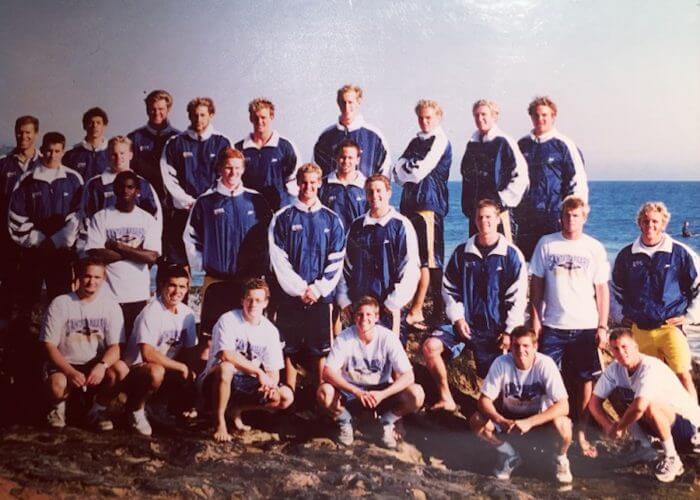
With the 1998 UC Santa Barbara Water Polo Team. Photo Courtesy: C. Weatherspoon
There was a lot of curiosity—being a Black, private school kid from New Hampshire was anomalous on a lot of levels. One of the things I enjoyed more than anything was going to my teammates’ houses and seeing California.
That’s how I got introduced to California in a day-to-day sense—going to their houses, meeting their families and friends. Guys would take me surfing… things that guys on the team did which for them were what life was about.
Ultimately if you’re going to be a college athlete you should buy into the camaraderie of the team, have respect for your teammates and what it’s about to work together. Sports like golf, tennis, swimming are different because you’re competing in a team framework but in a lot of ways you’re competing for yourself.
Those are unique experiences and they’re fundamentally different from being on a water polo team, or baseball or basketball. The interconnectedness and the shared responsibility you have manifests very differently.
– Water polo is perhaps the ultimate team sport. But, its participants represent a very particular subset of America: Californians, affluent, white. As a UCSB athlete playing other California teams, did you experiences any challenges because you were a Black athlete from the East?
No, that was never really an issue that I faced. Other Black players, I’ve spoken with them and that’s been a part of their experience but I never had that as part of my experience or in games.
It’s just never come up in my water polo experience as a player.
As a coach, as a spectator, different things have happened, but not in my playing experience, and I’m happy for that.
I was a center in high school and was learning the position at the college level. I only played for two years and I was injured the whole time. One of the things that you’ll find about me and UCSB water polo is that I got a letter when I was there; I was red-shirted my first year but was hurt. I have no UCSB water polo stats.
Which is a fascinating experience because water polo became such a huge part of my life and I was not a UCSB water polo legend—I really loved the experience and started coaching in the Santa Barbara Water Polo Club when I was a senior.
– From that formative experience, you not only stayed in California for your career but embraced water polo, becoming an age group coach.
I spent my junior year abroad in Egypt. When I came back I was really missing water polo big time. I started playing masters. Then I wanted to coach. I went back to Joe and said I wanted to be involved in water polo somehow. All the guys I came in with were seniors and I would go to all the games. I did some announcing for the college radio station, which was fun. Then I started coaching—which pushed me into club.
I coached at Santa Barbara Water Polo Club for a couple of years and then went to Marin Water Polo Club. I coached there and taught and coached at Marin Academy, a high school in Marin, which was awesome. Then I got invited to coach at Stanford, where I coached for a number of years. which was really wonderful.
– What was it like to be invited to coach at one of the best age group clubs in the country?
Jon Barnea, one of my really good friends who I had coached with at the Santa Barbara Water Polo Club, is the Stanford men’s assistant. We were talking for years, coaching against each other—14U. He was coaching at Palo Alto High School before he became the Stanford men’s [assistant] coach.
They were looking to build their program further and he spoke with John Vargas and Brian Kreutzkamp and they said “Get this guy to come and coach with us.” I decided to make that move down there. I taught at Sacred Heart in Atherton for a year, then ended up returning to San Francisco to teach but stayed coaching at Stanford.
– Obviously, education is a big part of your background and a life-long occupation. How is your focus on teaching reflected in your work for Stanford Water Polo Club?
Being a teacher and a coach are the same. In order to get people to perform at a high level at anything, you have to teach them why they should be doing what they’re doing. Clarity of instruction, consistency of values around how you relate to the facility, the coaches, the kids your training and competing against—those things really matter.
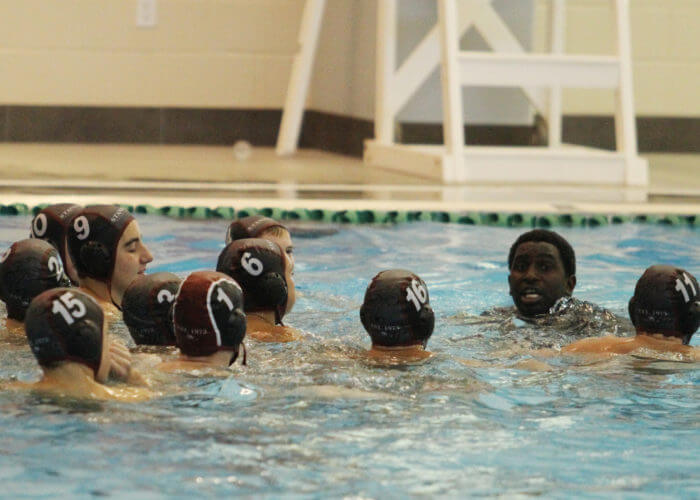
Celebrating a 2013 Champions Cup victory. Photo Courtesy: USA Water Polo
One of the big goals was to get kids to understand the connection between excelling in sports and excelling in life. How do you take lessons, experiences and values in life and extrapolate them to other places? For me, I learned a lot of things in sports that I was able to use elsewhere—including in school—and I still use in my life.
When I was growing up was an era of coaches with loud voices yelling at people. That has died down a lot—maybe the advent of Positive Coaching Alliance or any of a number of organizations that are about treating athletes with dignity and respect.
As a youth athlete my coaches were tremendously caring—overwhelmingly so. So many coaches I had were gracious, caring, loving, motivating. I feel that providing that level of care to athletes is really important.
There’s the phrase of: “Playing things the right way” which people overuse, but there is an integrity that should be evident in your team when you play, travel, when you talk to other kids. It should be a positive experience from competing against you—which should be difficult. It should be hell but it should be fun.
Water polo is a really physical sport that was always demanding but also fun. I think about competition against players who were as good or better—and how much fun I had. So, trying to balance for our kids competing at a high level, respecting the people you’re playing, having fun with the physical challenge and being able to understand how important it is to carry yourself with dignity and treat others at the same level.
That’s one of the things we offered at Stanford.
– Which is no surprise; it’s a reflection of the values of the institution your club is associated with.
At Stanford we’d have 80, 90 kids in our 14U group. I felt a great responsibility to help the highest-level athletes we had win games. There was an emphasis on winning. I’d say that to kids; we’re here to have a good time, and we want to teach all these values. But we’ve got 100 kids here—let’s figure out how to win some games! And that requires on the part of the coach, instruction.
You have to teach people how to win games. You obviously have to be good at player selection. You have to be able to communicate to kids why they’re not making teams—and I got a lot of help with that. I asked a lot of questions of a lot of people who were very generous in sharing that information.
In the years where it works out, you can end up winning a lot of games. Sometimes, you just compete a lot. And, sometimes you get smoked.
You have to create a culture where kids want to come back. They view it as something they like—they like spending time with you as their coach, that matters. They say: If that coach is gonna be there, I want to go.
Part of what’s amazing about being at Stanford is it’s the best facility anywhere. That facility sells itself—forget about who’s competing, just being able to coach there… to be in the middle of four amazing pools and this huge stadium. To see all these former and future Olympians. One day I met Greg Louganis on the pool deck.
I went up to him and said: I’m a huge fan!
There’s not a lot of pools where you can see Louganis, Katie Ledecky, Simone Manuel, Tony Azevedo and Ben Hallock on the same day.
– In 2014 you were recognized with USAWP’s Ted Newland Distinguished Men’s Coaching Award. Did you get to meet Coach Newland?
No, I never met Coach Newland. He’s a legend in our sport and my understanding—I know a lot of guys who played for him at UCI—his dedication to hard work, his ability to teach players, his focus on high-level player development is something I think is interesting.
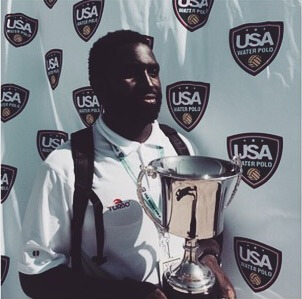
2015 National Junior Olympics hardware. Photo Courtesy: Jon Barnea
It’s obvious from the number of Olympians he developed in college how skilled he was at taking athletes where they were and helping them understand the mental element of the game as well as the physical demands that one has to put on oneself in order to excel. That is something that really stands out about what’s so important about his teaching and coaching.
It was a huge honor to win that award for player development. For me as a coach, I think about the developing players at any stage—and I don’t think these two things are in opposition. It’s one thing to be on the bench with a great team that you haven’t developed and coached versus developing players. I think those two things are very different.
When you’re developing players, sometimes you’re coaching them when they’re really good, and sometimes you’re coaching them when they’re learning. Sometimes, you’re watching them while they’re being really good.
Winning that award in large part was a testimony to being able to coach a few teams in a row of kids who were highly coachable, highly motivated, highly knowledgeable and they got a lot of results—and the award was one of those.
– Your role with USAWP’s task force on Racial Equity & Reform provides a platform to continue to work on behalf of the sport—and to advocate for communities of color to find their way to the pool and polo.
Any change effort that’s meaningful is a longer-term project. One of the biggest things is access. You have to be thinking about what’s the path to the pool. My path was really simple. My dad had a colleague who was starting a swim team and approached my parents. We were getting high-quality swim lessons at a really young age. And, the social event that I looked forward to the most was a pool party.
I think about how many kids I knew who hated pool parties—either because they couldn’t swim well or weren’t comfortable in a bathing suit. Those two things prohibit a lot of people from participating in aquatics.
This idea of creating more paths to the pool, more pools that people can access, more free swim [sessions]—and more engagement from community members at the lowest possible level of the sport. By that I mean more entry ways.
One of the things that drove me to coach 14Us was recognizing that in terms of player development, 14U was an important stage in helping kids become serious water polo players. Part of my job was finding kids who were basketball or baseball players who surfed—and getting those [athletes] to commit. There was some time coaching 6- and 7-year-olds who had never played before—what we called Junior Water Polo.
I did that at Stanford and I did that at Marin; how do you find those kids and how do you widen the range of your reach? If your pathways are broad, you can find more athletes who are going to be good later. You think about other sports—how many entry points are there for kids to play basketball or soccer? That’s how you end up with Kobe [Bryant], or Shaq [O’Neal] or Mike Trout. You think about these players who are phenomenally good; part of it is there’s so many places where you can play those sports.
If we want to think long-term, what decisions are we making right now that in a decade will result in way more kids of way more backgrounds playing our sport, excelling, playing DI polo, making the national teams, playing in the Olympics?
– Time is a critical factor—and it makes sense to think in terms of a decade because how long change of this nature takes. But, it’s hard enough to think in terms of what’s happening next week let alone how things will look years from now.
I believe that the task force is think in big chunks of time. It will likely be a different group of people in a decade [who] will be doing that work. We are thinking about what we can do beyond exposure to skill-building.
[USA Water Polo Racial Equality & Reform Task Force Hosts Town Hall Discussions on Zoom]
There’s an activity that I’ve done in a lot of schools which is: Describe a place where you feel the most comfortable. When I’ve done this exercise, the place that I’ve always named is the pool. I love walking onto a pool deck and hearing the water in the gutters, seeing the flags, hearing the sounds of swimmers doing freestyle. All those things feel like home to me. But that’s because when I walk on the pool deck I feel like I belong [there].
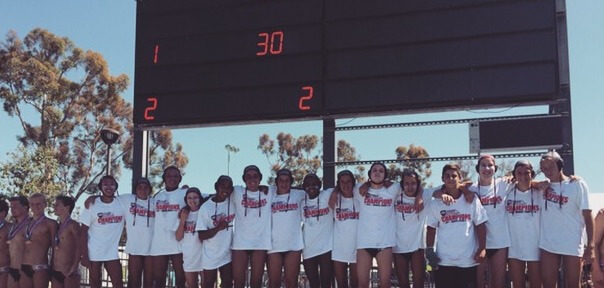
Stanford Water Polo Club at the 2015 Junior Olympics. Photo Courtesy: C. Weatherspoon
A really important part of what we have to work on in the long- and short-term is creating cultures so that people of all classes feel like that can walk on to a pool deck and they will be welcomed. They will be treated with love and care and respect.
That’s not the case at every pool.
One of the biggest challenges that we face nationally—which is what John Abdou has talked about—is we have had real segregation of aquatics. Not just racial segregation but class segregation. The idea that only people who have money or who are part of certain clubs have access to the pool. Only people of certain skin colors or certain genders. We don’t have to go back that far to a time when there was no women’s water polo.
In my high school when I played, there was no women’s water polo—it didn’t exist. When you look at all the water polo teams from 1970-something to the year I graduated, 1997, there was one woman in all those photos, and she played men’s water polo. [It’s a] gender-divide where we’re watching our women’s team just ball out, we’re working on that—there’s a focus on men’s water polo even though our women’s team is phenomenal.
That’s an equity issue right there.
What are the ways as a sport can we make it so that anybody who feels like showing up at the pool is a good idea—and they should bring their friends. There’s a no horsing around policy at pools, but kids have to be able to show up and be kids.
– There’s a whole other discussion about the Alliance for Equity and Diversity and how their mission dovetails with your task force’s approach to the issues at hand—and how to effect concrete solutions.
One of the things about the Alliance and about the task force is identifying this idea that: We have this sport—and Felix [Mercado] said this the other day—that mirrors a lot of what we see in our broader society. We have challenges in our society and they also exist in our sport. It would be naïve to believe that they don’t. Many of us want to address them.
The fact is, we have a really great sport and there’s a lot of great people who play this sport. In terms of friends I’ve made, opportunities I’ve had—I’ve encountered some wonderful people. So many of them from all backgrounds want to see our sport grow and they want to share the soul of that sport.
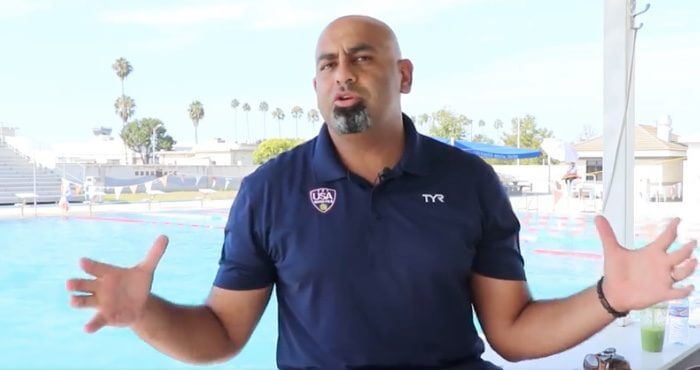
John Abdou. Photo Courtesy: USA Water Polo
There’s a huge need for coaches’ education. Being a good water polo player is not the same as being a good coach. We as a generation of players—I’m thinking of the players my age and generations behind me—need to invest in learning how to coach. They need to invest in younger generations, sharing that knowledge because [polo] is a unique sport. It’s very hard to not play and teach it.
My high school coach never played—he was a phenomenal teacher of the sport because he was a phenomenal teacher. Water polo, swimming, track—a great coach in all three areas because he was such a great teacher.
Teaching water polo is difficult to teach if you’ve never done it. People who have played need to be educated in the skills of coaching, which are not just technical. There’s also people skills and values education—and make sure we combine that with expanded access, inclusion education and training—really embracing growth.
That’s the reason I joined the task force. The mission and outlook is really positive. I would love to see the United States winning in the Olympic Games. I would also love to see people of all backgrounds, when I run into them say: Hey man, I play water polo, too.
I would love to have that conversation with people of all backgrounds, all social classes, all races, all genders—have them say: I played water polo, and it was great.




Great article Clark…….. glad to hear a former SB faculty kid us doing so well…… my husband taught at SB from 1967-1979……. knew your parents well…..I remember your brother Benjamin most…., Water has always been my happy place as well….. God bless, Barbara Lorch
Congratulations Clark, Carol
Waters
Great article Clark. Congrats!
Clarke nails it here. Thanks for sharing your experience.
We’re looking to continue to develop the High School program in Colorado, and I see some of the challenges are the same as they still are in California. Coaching IS essential. Whatever good coaches or connections you can send our way, Clarke or other readers, we’re open to you.
It comes down to opportunity and taking advantage of the open doors. Frankly, I think the Polo community does a pretty good job.
Eric- I can not believe I would read this article AND discover you through Clark. Our son, who went on to play D1 waterpolo in college, played on the Stanford Club teams and had Clark as a coach there too. Clark brought more than just Water Polo skills to the boys, introducing them to yoga and mindfulness in their earlier years. Love the sport, the community for both men and women. Our son is moving to Denver next month and I jokingly said to him he should start a water polo youth team.
Also appreciate that water polo is a low cost sport for equipment! Does not exclude athletes because of the cost- need only a suit, goggles and cap; And can promote college opportunities and beyond. I appreciate the talent and time commitment every coach makes- they do not do this for the money.